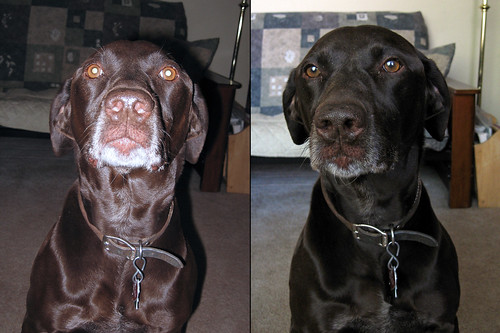Reader Question: Getting Rid of 'Creepy Eyes'
Frequent blog reader Michelle from the What's Up Michelle blog dropped me an email yesterday with a question. I asker her if she'd mind if I answered publicly and she gave me the go ahead.
"The camera I use is a Canon A540, digital. When I take photos of my dogs, I get the eye shine. How can I take some candid photos in normal lighting / every day setting, without getting the glowing eyes, which is kinda creepy."
Great question, Michelle. Camera's such as yours are designed to do much of the thinking for the photographer. This makes it easy for the novice shooter to simply aim the camera and press the shutter release without having to worry about the various settings. That's why these type of camera's are commonly referred to as "Point and Shoot".
One of the settings that the camera does automatically is the decision of when to use flash. I have noticed with many point-and-shoot models that they use the flash on nearly all shots. Since this flash is located very close to the camera's lens, its light bounces off the back of your dog's retinas to create the "creepy" look. Many advanced photographers avoid this "creepiness" by either bouncing their flash off of the ceiling or moving it away from the camera. Unfortunately, neither of these solutions is available for you. A solution I would use is to avoid using the flash for these types of shots and to manually adjust the camera's settings.
To illustrate this, I borrowed my daughter's Canon A530 which is very similar to your camera. I then called over Holly, our always willing German Shorthaired Pointer, to serve as a model (it did cost me a piece of cheese).
In the shot on the left I used the camera on the fully automatic setting. Notice how it not only created the "Creepy" eyes, but the flash also overexposed the end of Holly's nose and created a large shadow. This did not make for a very flattering photograph.
In the other shot (on the right), I put the camera in manual mode, adjusted the aperture to its widest setting to allow in maximum light and disabled the flash. Note how much more even the lighting is on Holly and how her eyes look normal. I feel that this capture looks much more natural and pleasing.
Keep in mind that this method worked in part because I had a good amount of natural light in the room. If the room had been darker it would have been more difficult to get a good result without the flash. For some more information and tips on photographing without a flash, you might refer to a post a did a few weeks back on low light shooting (here's a link).
I hope this answered your question, Michelle. If any other readers have suggestions as well, I'm sure they'll chime in.
Labels: tutorial




3 Comments:
Two things come to mind which you may be able to experiment with:
1) Put a piece of masking tape (or something similar) over the flash to help diffuse the light.
2) Get a small hand mirror and hold it at an angle in front of your flash to bounce it off the ceiling.
Hope that helps,
Harley Pebley
Wow - Thanks! This is great! I really appreciate your advise. Thanks for taking the time to explain and provide examples (Holly is a beautiful model)! I feel armed and ready to shoot some non-creepy photos of my doggies! :)
Nowadays, even "point and shoot" cameras have many helpful adjustments that can be made. I have a new one, and there are a surprising amount of settings that can be made. It's just a matter of reading the manual carefully and experimenting to see what the effects are -- and then remembering, when the photographic moment is at hand, to apply what has been learned. (The last point is the most difficult and most important.) Or then again, you can just point and shoot and often the results are pretty good, which is the great virtue of such cameras.
Post a Comment
<< Home